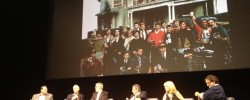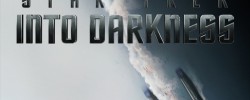
Review: Kon-Tiki (2012)

Cast: Pål Sverre Hagen, Anders Baasmo Christiansen, Gustaf Skarsgård
Director: Joachim Rønning, Espen Sandberg
Country: UK | Norway | Denmark | Germany
Genre: Action | Adventure | Biography | Drama | History
Official Trailer: Here
Editor’s Notes: Kon-Tiki opens in limited release tomorrow, April 26th. If you’ve already seen the film we’d love to hear your thoughts on it, or if you’re looking forward to seeing it this weekend, please tell us in the comments section below or in our new Next Projection Forums.
Against the brilliant white landscape of a snow-laden Norwegian town, a black figure appears, harshly contrasted with its surroundings as it moves—closer, slowly closer—toward us. It, we soon learn, is he: the young Thor Heyerdal, defiantly striding toward the camera amid a chorus of rising chords to stare it—and seemingly us—in the eye. So strange a juxtaposition between the cinematic immersion of the unbroken shot and the sharp subversion of the direct address is a fitting beginning for Kon-Tiki, a film that strives to balance the reality of the eponymous vessel’s voyage—made famous in the 1950 Oscar-winning documentary of the same name—and the embellishing demands of a big-budget adventure.
Meeting his indelible conviction as much as they do his apparent madness, Rønning and Sandberg make of their film a resolutely thrilling adventure movie and a reliably affecting survival tale.
 The fifteen and a half million US dollars to which the film’s budget equates is but a pittance in Hollywood, yet Kon-Tiki stands the most expensive Norwegian film ever made, a good indication of the celebrity stature the nation affords Heyerdal. Directors Joachim Rønning and Espen Sandberg, breaking their own record for 2008’s Max Manus: Man of War, lend an epic scope to the production; their decision to film on the open seas seems almost as foolhardy an undertaking as Heyerdal’s 1947 quest to prove the ease with which ancient settlers could have drifted from Peru to Polynesia on something as simple as a balsa wood raft. Meeting his indelible conviction as much as they do his apparent madness, Rønning and Sandberg make of their film a resolutely thrilling adventure movie and a reliably affecting survival tale.
The fifteen and a half million US dollars to which the film’s budget equates is but a pittance in Hollywood, yet Kon-Tiki stands the most expensive Norwegian film ever made, a good indication of the celebrity stature the nation affords Heyerdal. Directors Joachim Rønning and Espen Sandberg, breaking their own record for 2008’s Max Manus: Man of War, lend an epic scope to the production; their decision to film on the open seas seems almost as foolhardy an undertaking as Heyerdal’s 1947 quest to prove the ease with which ancient settlers could have drifted from Peru to Polynesia on something as simple as a balsa wood raft. Meeting his indelible conviction as much as they do his apparent madness, Rønning and Sandberg make of their film a resolutely thrilling adventure movie and a reliably affecting survival tale.
Whether slavishly labouring over the period detail of 1940s New York or exploring the seemingly boundless horizons of the South Pacific, Rønning and Sandberg’s direction is the driving force of the film, at once operating in the registers of dramatic intimacy and action spectacle. Employing a deluge of digital effects, it’s the ultimate devotion of their craft to storytelling that makes this such a visually—and thereby narratively—engaging work: it is undoubtedly a spectacular movie, but the spectacle is firmly rooted in the representation of this voyage and the underlying motivations and emotions of its six-man crew. They, led by Pål Sverre Hagen as Thor, comprise a cast driven by the nuance of implicit expression, the tensions of their closed confines given life through the peculiarities of body language and the resounding loudness of those words that go unsaid.
The concerns of big-budget filmmaking play heavy on the narrative framework of the film, which gradually moves from permissible dramatic licence to full-scale cinematic excess, characters toppling into the water just as a shark happens to arrive more than their fair share of times.
 For all the subtlety of expression underpinning the cast’s interaction, they are one of the many aspects of the film ill-served by its incessant deference to the safety net of blockbuster sensibility. The concerns of big-budget filmmaking play heavy on the narrative framework of the film, which gradually moves from permissible dramatic licence to full-scale cinematic excess, characters toppling into the water just as a shark happens to arrive more than their fair share of times. Conflict is the defining element of the basic three-act structure to which the story is inevitably confined, and Rønning and Sandberg progressively sacrifice their serious exploration of their protagonist’s obsession for yet another unfounded shouting match between the men, overblown to the point of hysteria by the shamelessly manipulative score. Never better are the consequences of the film’s commercial concerns seen than in a sequence where Thor, struck with inspiration for the voyage early in the film, rushes to a Brooklyn rooftop and gazes at the setting sun, which brilliantly illuminates a giant sign. In a film—as seen through the names of its main character and titular vessel both—so clearly concerned with gods and men, nothing seems more cast in a divine light than the logo of Pepsi-Cola.
For all the subtlety of expression underpinning the cast’s interaction, they are one of the many aspects of the film ill-served by its incessant deference to the safety net of blockbuster sensibility. The concerns of big-budget filmmaking play heavy on the narrative framework of the film, which gradually moves from permissible dramatic licence to full-scale cinematic excess, characters toppling into the water just as a shark happens to arrive more than their fair share of times. Conflict is the defining element of the basic three-act structure to which the story is inevitably confined, and Rønning and Sandberg progressively sacrifice their serious exploration of their protagonist’s obsession for yet another unfounded shouting match between the men, overblown to the point of hysteria by the shamelessly manipulative score. Never better are the consequences of the film’s commercial concerns seen than in a sequence where Thor, struck with inspiration for the voyage early in the film, rushes to a Brooklyn rooftop and gazes at the setting sun, which brilliantly illuminates a giant sign. In a film—as seen through the names of its main character and titular vessel both—so clearly concerned with gods and men, nothing seems more cast in a divine light than the logo of Pepsi-Cola.
There’s a scene toward the end of the film where Thor and his men, fatigued from a day of fighting storms and sharks, gaze upward at the clear night sky as the camera adopts their perspective and climbs slowly to the stars, drifting through the ether and slowly turning to gaze back down upon them again from the heavens. For much of the film we are as they: awestruck, dumbfounded by the wonders of the world and our own place beneath the constellations which guided generations upon generations before us. It’s in moments such as these that Rønning and Sandberg manage to touch upon greatness. More often, they and their film fall prey to budgetary concerns beyond their control. Much like the craft from which it takes its name, Kon-Tiki is borne on a purpose of noble beauty, but caught at the mercy of currents it cannot hope to control.
Related Posts
![]()
Ronan Doyle
![]()
Latest posts by Ronan Doyle (see all)






























